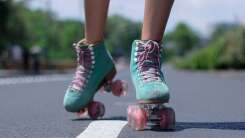How to Start Roller Skating Without Breaking Anything

Roller skating has always felt like freedom to me. When you’re going fast, you’re flying. Even when you’re tootling around in a small space, doing little pivots on your wheels, you’re moving on your feet in ways that the rest of the world, clad in their sad little shoes, could never. So how can you join the ranks of the roller skaters? It will take a little investment of time and practice, but soon, this could be you.
I used to play roller derby, so I spent years getting comfortable on my skates. In my spare time, I’d practice figure skating moves like turns and jumps, and silly little tricks like “shooting the duck.” (During the pandemic lockdowns, I briefly dabbled in skate dancing, which it turns out I am not very good at.) Today I’m going to break down the most essential beginner tips so you can get started as quickly as possible.
Get some skates
When we’re talking about “roller skating,” I assume that you and I are both thinking of quad skates, the kind that have four wheels, two in the front and two in the back. (I also hear there is something out there called a “roller” “blade”? No idea about those.)
There are two types of quad roller skates you’ll see around. The ones with heeled boots that lace up the ankles are made for doing figure skating moves like jumps and spins, and they work well for casual skating as well. These are your classic retro-style roller skates.

$115.00
The other type is a low-cut skate that looks more like a sneaker. These give you zero ankle support, but more flexibility. They’re great for the fancy footwork of jam skating, and this is also the style preferred among roller derby players.

$167.84
Either type is fine to start with, and I’m not gonna judge you if you pick your skates based on what looks the cutest. Just a word of warning: While it’s often a good idea to buy the cheapest option first and upgrade when you wear it out or surpass its abilities, with skates you want to make sure you don’t go too cheap. Anything below $80 or so is suspect.
Some skates are too flimsy or don’t have proper equipment. To spot what’s wrong with them, it helps to know a little skate anatomy. Under the boot (the shoe part), we have a plate. The plate needs to be strong enough to support your weight. And then, connecting the wheels to the plate, we have the trucks. These are a moving part that allows some movement between the wheel axle and the plate. It has cushions and is attached to the plate at an angle. Here’s a video that explains the anatomy:
window.videoEmbeds = window.videoEmbeds || []; window.videoEmbeds.push({
elemId: ‘video-container-mskLcvIZkrA’,
data: {“slug”:”mskLcvIZkrA”,”start_time”:”178″,”url”:”https://www.youtube.com/watch?v=mskLcvIZkrA&start=178″},
videoPlayerType: ‘in-content’
});
So as you’re looking at skates, make sure your chosen pair actually has these parts. For example, if the area connecting the wheels is just a smooth piece of plastic, like on these kids’ skates, you don’t have trucks at all. That means you can’t adjust your trucks, which means you’re really limited in the type of movement you can get out of them. You also don’t have a way of replacing the trucks without replacing the entire skate.
Another thing to watch out for: Nylon (soft plastic) plates tend to flex too much for people who weigh over 200 pounds or so. Kids and lightweight adults will find these work just fine, but everyone else should look for aluminum or fiberglass plates instead.
Some budget-friendly beginner brands:
-
High ankle skates (retro/artistic style): Candi Grl, Impala, Moxi Beach Bunny, Riedell Wave
-
Low cut skates (derby/jam style): Riedell R3, Riedell Dart, Sure-Grip GT-50
Get some safety gear
Until you fully develop your instincts for falling safely, it’s smart to wear safety gear while you practice. You will fall on your knees, so get kneepads. The skater kind with hard caps are best, but if you want to live a little dangerously, I sometimes use thin dancers’ kneepads like these. If you fall with these on, it will still hurt, but the pad kinda takes the edge off. Get a helmet to protect your head, and consider elbow pads and wrist guards.

$39.99
Know some basic skate maintenance
There’s a couple things you’ll need to do with your skates to keep them rolling smoothly. First, be able to tighten or loosen the nuts on your wheels. Often, skates will come with the nuts too tight. Make sure they’re loose enough that when you hold the skate up and flick the wheel, it spins freely.
A basic skate tool (like this one) will include a socket for the wheel nuts and a socket for the nuts on your trucks. Looser trucks will steer more sharply, but they’ll feel more wobbly. You’ll need to adjust your trucks to match your skill level and suit the type of skating you want to do.
If you mainly skate on hard indoor floors, you’ll want hard wheels (with a durometer rating in the 90s, such as 90A). If you skate outdoors, softer wheels will give you a smoother roll over rough pavement; the durometer rating for those will usually be in the 80’s. Many skaters have a set of outdoor wheels and a set of indoor wheels, and swap them out accordingly.
Your toe stops are another thing to check. Some dance moves work best with no toe stops, so you might want to take yours out and replace them with little nubs called jam plugs. On the flip side, if you skate outside a lot, you may find yourself using your toe stops so much you wear them down. Toe stops can be replaced, and some types allow you to adjust the height, which usually requires an allen wrench.
Get comfortable on your skates
The first step in learning (or relearning) to skate is simply training your body in how to move when you have wheels under you. The fastest way to accomplish this is to just wear your skates at home, whether your house contains good places to skate or not.
That said, use common sense: Don’t practice in an area where sharp or delicate things are within reach. Never try to go up or down stairs or navigate tricky terrain until you’re very sure of your skills.
Even if all your floors are carpeted, you’ll get the sense of where to place your weight on your foot as you walk around. Perhaps you’ll find yourself popping up onto your toe stops to get up from a chair. And when you wear your skates in a small space, like in your kitchen while you’re washing dishes, you’ll discover all kinds of ways to pivot and maneuver on your wheels while you’re standing still. All these skills will serve you well when you move out to the rink or the dance floor or the street.
Skate without falling down
You only need a small space to practice the basics. First up, your body position: Always bend your knees at least a little. This helps you to keep your balance, since now you can shift your weight as needed. (Locked knees are a no-no, at least until you’re more advanced.)
Learn to stand in a T-stance: Put one foot perpendicularly behind the other. This is very stable, and is how you should stand when you aren’t intending to roll anywhere. You can also push off from the sideways skate to get moving. For example, if the side of your right foot is behind your left heel, you can push from your right foot and skate gracefully forward on the left.
Steer on your skates by leaning to the side. With practice, you’ll be able to skate in a circle on one foot. (The looser your trucks, the smaller the circle.) To stop, have all your weight on one foot, and slowly bring your other foot behind in that T position. To keep your ankles safe, make sure you’re dragging all four wheels of the back foot on the ground, not just the two wheels closest to the moving skate.
Learn some moves
Now we get to the fun part! What are you going to do on your skates? If you plan to head outdoors, remember your helmet and kneepads and start with smooth, flat areas.
Indoors, you can do a lot in a small space. The video below shows some fancy-looking dance moves that are made out of basic steps, like sliding your feet back and forth.
window.videoEmbeds = window.videoEmbeds || [];
window.videoEmbeds.push({
elemId: ‘video-container-Uf41xuVOLnk’,
data: {“slug”:”Uf41xuVOLnk”,”start_time”:null,”url”:”https://www.youtube.com/watch?v=Uf41xuVOLnk”},
videoPlayerType: ‘in-content’
});
Whatever you choose, stay safe, know your skates, and don’t be afraid to get creative. Support your instructors with a donation anytime you can, and post your moves to social media to encourage others. Happy skating!



